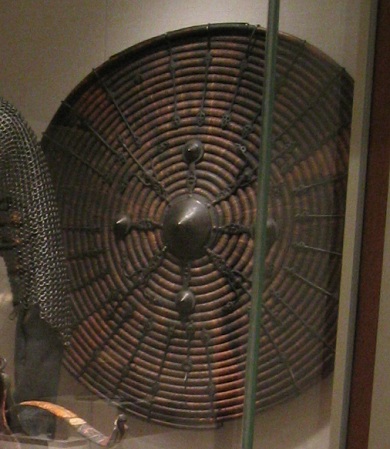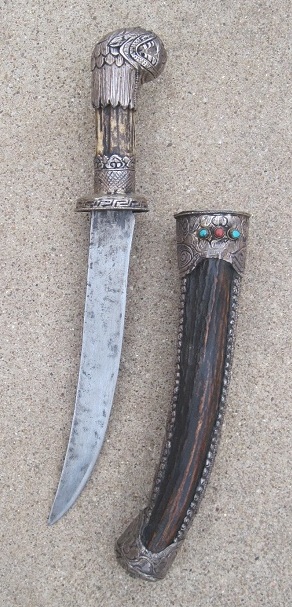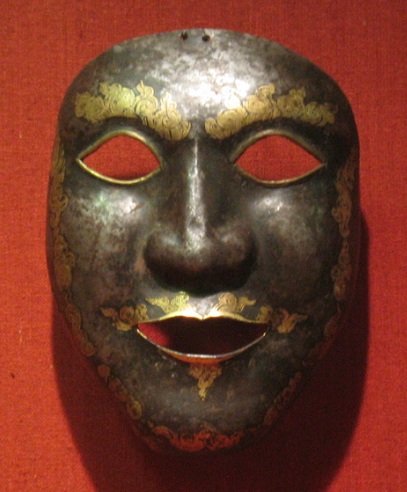Subject: gzim sbyong pa / zimchongpa heavy infantryman
Culture: Tibetan
Setting: Tibet 14-17thc
Context (Event Photos, Primary Sources, Secondary Sources, Field Notes)
* Warriors of the Himalayas 2006 p8-9 (Donald J LaRocca, "Rediscovering the arms and armor of Tibet" p3-20)
"In the next and very tumultuous period of Tibetan history, from roughly the middle of the fourteenth century until 1642, power was held by three successive secular dynasties, the Phagmodrupa, the princes of Rinpung (rin spungs), and the kings of Tsang. ... By the middle of the fourteenth century, after a period of violent struggle, the preeminent position of the Sakyapa was taken by the secular arm of the Phagmodrupa, a branch of the Kagyu school. ... By the late fifteenth century, after a long rivalry, the Phagmodrupa, who were allied with the Gelugpa, were supplanted by their former ministers, the princes of Rinpung, who were based in Tsang and supported by the Karmapa. In the 1560s the Rinpung were themselves supplanted by their ministers, who established the line of kings of Tsang, the last native Tibetan secular monarchy, which remained in power for approximately eighty years. ...
Helmet
* Robinson 1967 p161
"The helmets are rounded in form, built up of eight radial segments laced together with leather thongs. The plates are arranged so that half their number are inside and half outside, the external ones overlapping an internal one on each side. The external plates each have a medial rib and are cusped between the lacing holes. A moulded iron plume-tube is laced to the centre by its base-plate, and the lower edge is finished with a band of lamellae to which in turn are laced neck and cheek defences, each constructed of three rows of lamellae."
* Warriors of the Himalayas 2006 p52
"[D]istinctive helmets were made to match the lamellar armors and, like the armors, are associated only with Tibet or the Tibetan cultural region. Also, like the armors, this type of helmet is constructed of iron plates joined by leather laces. The bowl of the helmet is usually made up of eight arched plates, but there are also examples with sixteen plates. The plates are wedge shaped and overlap in an over-under sequence, with four narrow outer plates that have cusped edges, and four wider inner plates that have smooth edges. The side edges of the outer plates usually have two shallow cusps with rounded points, although on some examples the points are much more attenuated. The outer plates also usually have a low medial ridge, while the inner plates are smooth. On some examples, however, the medial ridge of the outer plate is high and pronounced, and the inner plates also have a medial ridge. The outer plates typically have ten lacing holes and the inner plates fourteen, but this can vary. At the bottom edge of most plates there are usually a series of small notches, which probably served as assembly marks. The tops of the inner and outer plates meet beneath the base of a plume finial, which fomrs the apex of the helmet, and resembles the stem and base of a footed chalice. The plume tube generally has a central lozenge-shaped knob and a flaring funnel-like top. The base is pierced with eight lacing holes arranged in four pairs of two, which are laced to corresponding holes at the tops of the four inner plates. The tops of the outer plates do not have lacing holes, but are slightly stepped to fit snugly under the base of the finial. On complete examples there is a single row of lamellae encircling the base of the helmet bowl, a pair of cheek defenses made of five to seven rows of lamellae, and a flaring nape defense of three rows."
* Stone 1934 p54
"The helmet is made of eight well forged plates, four plain, and for with scalloped edges and raised ribs, that overlap the others and are laced to them. There is a small round plate with a knob on it at the crown. The neck guard, like the body armor, is made of small round-ended scales laced together with leather."
Armor
* Warriors of the Himalayas 2006 p50
"In Tibetan the lamellae are referred to as byang bu, a general term for a small label, card, or flat object of rectangular shape. It is used to modify the Tibetan word for armor, khrab, giving the term byang bu'i khrab, for which the best English equivalent is lamellar armor. [...]
* Robinson 1967 p161-2
"The normal body armour was in the form of a long coat, entirely constructed of horizontal rows of iron lamellae laced together with doeskin. It was customary for all iron to be polished bright and the hide to be its natural cream colour. The coat of lamellar opened down the front, and the long skirt had two further openings provided towards the rear of each hip -- so that when the wearer was upon horseback the rear portion of the skirt was spread over the horse's crupper. The coat was joined over the shoulders by straps constructed of small lamellae -- usually older, large ones cut down, laced together and lined with leather. To these straps the flaplike shoulder defences were laced permanently. They varied in length according to the number of laminations, but in some instances were made to wrist length and laced up on the inside. To the bottom edge of the skirt it was customary to lace irregular pieces of buckskin or leather fringes.
* Stone 1934 p54
"The earliest Tibetan armor of which we have any account was called 'willow leaf' because it was made of long narrow scales laced together."
Shield
* Warriors of the Himalayas 2006 p146
"[S]hields were widely used at certain points in Tibetan history. They were invariably round and consist of two basic types: shields made of wicker or cane (sba phub), and shields made of leather (ko phub). Of these, the cane shields seem to have been made in Tibet, while most if not all of the leather shields appear to have come from India, Bhutan, Sikkim, and probably Nepal. The cane shields have two principal forms: flat and domed or convex.
"[...] Domed cane shields in Tibet can be completely plain or have varying degrees of painted decoration. This type has a small central iron boss and is held by a single handle in the center of the back.
* Peers/Hook 1997 p46
"The shield is of woven bamboo, and was large enough to be slung on the back in retreat, covering most of the body. According to Chinese sources, shields were sometimes plated with iron and painted with pictures of tigers."
* Robinson 1967 p162
"Shields were not generally used in Tibet, but examples found there are small, slightly convex, and made of laquered buffalo hide. They have four brass bosses covering the hand-loop rivets and a fifth which is purely ornamental. They may have been acquired from Bhutan, where this defence was more generally used."
Sword
* Warriors of the Himalayas 2006 p146
"The third type [of Tibetan sword] is also straight, but is double edged and has a symmetrical tip. This is found on some very early styles of swords, but also occurs later."
Dagger
* Stone 1934 p491
"PECHAK. A dagger, Western Tibet." [reference omitted]



